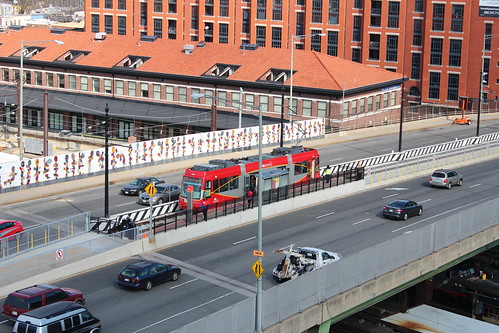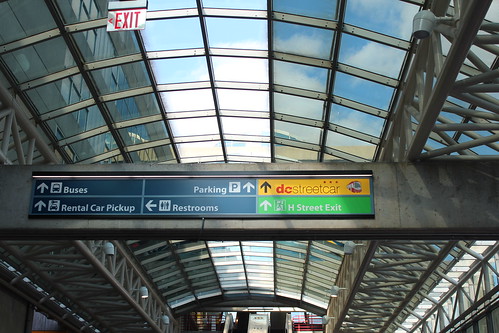A brief streetcar followup: miscellaneous
1. I forgot to mention that Congressman Earl Blumenaur of Portland, Oregon, the leader of what we might call the sustainability caucus oin Congress, was at the launch.
A company he helped get some federal monies to manufacture streetcars in the US, later called United Streetcar, was one of the vendors for the DC program, although United Streetcar is now defunct, as the market for streetcars in the US didn't turn out to be particularly rosy, and other firms manufacturing rail-based transit vehicles are more diversified and able to withstand vagaries in demand for any one mode.
 Flickr photo by Matt Johnson.
Flickr photo by Matt Johnson.2. The Post had coverage on Saturday ("D.C.’s tortured quest to bring back streetcars: Boon to some, affront to others"), Sunday ("D.C. streetcar makes its first voyages on H Street. ‘Is it really happening?’"), and today ("Theory no longer, streetcars scrutinized by commuters, partiers"). GGW has a nice piece ("DC Streetcar's exuberant opening day, in photos and video") on the launch with lots of photos.
3. More real estate development. When I was cycling down Florida Avenue NE to the launch, I noticed three residential developments of significant size, likely each project is worth upwards of $20 million. So that makes a total of greater than $800 million in new real estate development in association with the streetcar, up from my earlier estimate of $779 million.
4. Urban design treatments to better mark the path between Union Station and the streetcar stop. One photo in the GGW group (Flickr photo by Matt Johnson) shows signage at Union Station for the streetcar, which "shocks" me because it was installed before the streetcar started running.

I'm glad they got this element right(er), because this is usually missed--for many years I've suggested the need for a rethink of transit wayfinding information there and other hub sites within the regional mobility system (e.g., main Metrorail stations downtown, airports, train stations, etc.). See the 2011 entry, "Master planning and DC's Union Station intermodal transportation center."
But because the streetcar stop is not well connected to Union Station, I'd have suggested a more visually distinctiveness treatment of the sidewalk environment between Union Station and the streetcar "station" on the bridge, although this would have necessitated some expensive reconstruction.
For example, blue architectural lighting is used around the main train station in Essen, Germany, to link the bridge supporting the train station platforms, local and inter-city bus stops around the station, as well as the subway platforms within the station.
Red sidewalks connecting Union Station to the streetcar stop, given the red painting scheme for the streetcar, might have been something I'd have recommended as an interim measure to get people between the train station and the streetcar stop--as it is people will have to come up from the subway platform to the main floor, then go up one more level to the entry to the parking garage/bus station, and then through the bus station to the bridge on H Street. The sign that's posted is not enough.
Red colored concrete sidewalk on Ocean Drive in Miami Beach.
Labels: commercial district revitalization, infrastructure, streetcars, transit and economic development, transit marketing, urban design/placemaking





0 Comments:
Post a Comment
<< Home